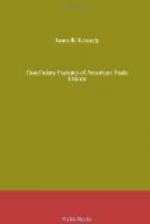[Footnote 124: Cigar Makers’ Journal, Vol. 6, Oct., 1880, p. 7.]
[Footnote 125: Ibid., Vol. 3, Oct., 1877, p. 3.]
[Footnote 126: Ibid., Vol. 5, June, 1879, p. 1; October, 1880, p. 7.]
[Footnote 127: Constitution, 1881 (New York, 1881), Art. 9.]
[Footnote 128: Cigar Makers’ Journal, Vol. 14, August, 1889, pp. 10-11.]
In the first national constitution of the Deutsch-Amerikanischen Typographia, adopted in April, 1873, provision was made for the payment of sick benefits by the subordinate unions.[129] The system, however, was unsatisfactory, and in 1879 and 1881 unsuccessful efforts were made to remedy its deficiencies. The desire for a better system finally led to the adoption of a national sick benefit at the New York convention in May, 1884.
[Footnote 129: 25-jaehrige Geschichte der Deutsch-Amerikanischen Typographia, p. 6; American Federationist, Vol. 2, No. 4, p. 60.]
The sick-benefit system of the Iron Molders’ Union may be regarded as next in importance to those of the Cigar Makers and the German Printers. Although organized into a national union in 1859 the Iron Molders have only within a very recent period turned their attention seriously to the establishment of beneficiary features. In 1866 President Sylvis urged the adoption of a funeral and a disability benefit, to which, he said, sick benefits might be added later.[130] Thirty years later, in 1895, President Fox advocated a national sick benefit as a necessary part of the Iron Molders’ beneficiary system.[131] But both of these officials cautioned the National Union against extending the national benefits too far, lest the protective purpose of the association be sacrificed to the benevolent. The unsatisfactory operation of the “Beneficial Association” in the early history of the Union, and later the experience of the Union with the death and disability benefit, had made the membership reluctant to sanction the establishment of any new benefit. A further deterrent influence was the almost total failure of sick benefits operated by the local unions.
[Footnote 130: Iron Molders’ Journal, Vol. 1, p. 309.]
[Footnote 131: Proceedings of the Twentieth Convention, Chicago, 1895 (Cincinnati, 1895).]
President Fox’s recommendation was effective, however, in securing the establishment of the sick benefit. The system became operative on January 1, 1896, and was essentially the same as that now in operation.[132] Provision is made for a weekly allowance of five dollars during a period of not more than thirteen weeks in any one year to sick members. The beneficiary must have been a member of the organization for six months, and not in arrears for more than twelve weeks’ dues.[133]
[Footnote 132: Iron Molders’ Journal, Vol. 31, No. 8, p. 3; Proceedings of Twentieth Convention, Chicago, 1895 (Cincinnati, 1895), p. 100.]
[Footnote 133: Constitution, 1895 (Cincinnati, 1895), Art. 17.]




